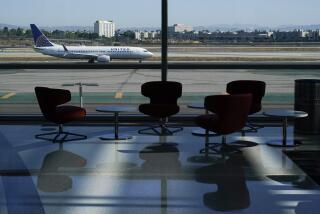Pressures May Lift O.C. Flight Limits
Facing industry pressure on John Wayne Airport in the wake of a failed El Toro airport plan, Newport Beach and Orange County supervisors are nearing agreement on lifting the cap at John Wayne to 10.8 million passengers a year eventually -- far more than people living in the flight path had ever anticipated.
That ceiling -- which would allow 1 million more passengers annually than proposed by the county earlier this year -- comes at a time of mounting opposition from the airline industry to local controls that conflict with a 1990 federal law banning city and county governments from limiting airport activity.
Aircraft noise restrictions and passenger volumes at John Wayne are now controlled by the county under a landmark 1985 court settlement that is set to expire in 2005. The original agreement, which ended a lawsuit by Newport Beach and others, had capped passenger volumes at 8.4 million a year. The airport now handles about 7.8 million air travelers a year.
The proposal, which would revise and extend the 1985 settlement, would increase airport capacity to 10.3 million a year in 2003, and to a maximum of 10.8 million by the end of 2011. The number of noisiest flights would be raised from 73 to 85 a day, and the number of gates would increase from 14 to 20. The entire agreement would expire in 2015.
The Newport Beach City Council and the county Board of Supervisors are scheduled to consider the proposal next week.
“This is far more than Newport Beach ever wanted at John Wayne,” conceded Mayor Tod W. Ridgeway. “But the quid pro quo for us is that the airlines will not file a lawsuit against us and the Federal Aviation Administration will take no further action.”
Neither the FAA nor the airline industry has taken an official position on the proposed agreement.
The latest plan builds on one reached by Newport Beach and the Board of Supervisors in June that would allow the airport, starting Jan. 1, to expand operations beyond the limits in the 1985 settlement.
Under the changes proposed in June, airport capacity would rise to a maximum of 9.8 million passengers year, 1.4 million above the 1985 cap. Adding four future gates also was approved, bringing the total to 18.
In an attempt to avoid litigation and maintain some local control, the city and county will ask the FAA to review the newer plan once it is approved to make sure it conforms to the federal Airport Noise and Capacity Act of 1990.
The FAA, which enforces the measure, has the power to sue over the proposed restrictions. If the agency signs off on the changes, local officials believe, airlines would be unlikely to raise a legal challenge as well.
Paul Turk, an FAA spokesman, said Thursday that the agency will review the proposal and comments from government officials and the airlines based at John Wayne Airport. The FAA could issue an opinion by the end of the year.
“Everyone wants to make sure this is locked down and that we are in compliance with federal law,” said Alan Murphy, director of John Wayne Airport. “The FAA interpretation is critical.”
The proposal, Murphy said, provides noise protections for communities near the airport while allowing more capacity after the public rejected a plan to turn the closed El Toro Marine Corps Air Station into a major commercial airport. An airport serving up to 30 million passengers a year at El Toro had been heavily favored by Newport Beach officials in hopes of lessening demand at John Wayne, which is just north of that city.
Murphy said those supporting the plan include the 10 commercial airlines now based at John Wayne, citizens groups, the Newport Beach City Council and members of the Board of Supervisors.
If approved by Newport Beach, the county and the FAA, an amended settlement agreement will be submitted in federal court. Newport Beach City Atty. Robert Burnham said it probably would go before U.S. District Judge Terry Hatter, who has signed off on smaller changes to the 1985 settlement.
“We want to make sure we get the benefit of our bargain and head off possible lawsuits over the restrictions,” Burnham said.
More to Read
Sign up for Essential California
The most important California stories and recommendations in your inbox every morning.
You may occasionally receive promotional content from the Los Angeles Times.










